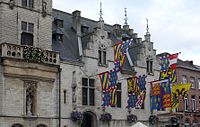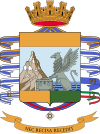Portal:Heraldry
Welcome to the Heraldry and Vexillology Portal!


Heraldry encompasses all of the duties of a herald, including the science and art of designing, displaying, describing and recording coats of arms and badges, as well as the formal ceremonies and laws that regulate the use and inheritance of arms. The origins of heraldry lie in the medieval need to distinguish participants in battles or jousts, whose faces were hidden by steel helmets.
Vexillology (from the Latin vexillum, a flag or banner) is the scholarly study of flags, including the creation and development of a body of knowledge about flags of all types, their forms and functions, and of scientific theories and principles based on that knowledge. Flags were originally used to assist military coordination on the battlefield, and have evolved into a general tool for signalling and identification, particularly identification of countries.
Selected coat of arms

A Scottish crest badge, more commonly called a clan crest, is a heraldic badge worn to show one's allegiance to a specific Scottish clan. Crest badges may be worn by any member of a clan. Even though it is the most common name, the term clan crest is a misnomer. There is no such thing as a clan crest. Modern crest badges usually consist of the clan chief's personal crest surrounded by a strap and buckle and the chief's motto or slogan. Although "clan crests" are commonly bought and sold, the heraldic crest and motto belong to the chief alone and never the clan member. Crest badges, much like clan tartans, do not have a long history, and owe much to Victorian era romanticism, having only been worn on the bonnet since the 19th century. The original badges used by clans are said to have been specific plants worn in bonnets or hung from a pole or spear. (more...)
Selected article

Heraldic visitations were tours of inspection undertaken by Kings of Arms in England, Wales and Ireland in order to regulate and register the coats of arms of nobility and gentry and boroughs, and to record pedigrees. They took place from 1530 to 1688, and their records provide important source material for genealogists.The first provincial visitations were carried out under warrant granted by Henry VIII to Thomas Benolt, Clarenceux King of Arms dated 6 April 1530. He was commissioned to travel throughout his province and was given authority to enter all homes and churches. Upon entering these premises, he was authorized to "put down or otherwise deface at his discretion...those arms unlawfully used". (more...)
Selected flag

The Flag of Europe is the flag and emblem of the European Union (EU) and Council of Europe (CoE) (it is also used to indicate the euro or eurozone countries). It consists of a circle of 12 golden (yellow) stars on a blue background. The blue represents the west; the number of stars represents completeness while their position in a circle represents unity. The stars do not vary according to the members of either organisation as they are intended to represent all the peoples of Europe, even those outside European integration.
The flag was designed by Arsène Heitz and Paul Lévy in 1955 for the CoE as its symbol, and the CoE urged it to be adopted by other organisations. In 1985 the EU, which was then the European Economic Community (EEC), adopted it as its own flag (having had no flag of its own before) at the initiative of the European Parliament. The flag is not mentioned in the EU's treaties, its incorporation being dropped along with the European Constitution, but it is formally adopted in law. (more...)
Selected picture

The town hall of Dendermonde, a city in Flanders, displaying heraldic banners.
Did you know...
- ...that the Italian mountain Cimon della Pala appears on the coat of arms of the Guardia di Finanza (pictured)?
- ...that King Edward III of England ordered stars effaced from the coat of arms of Sir Amery of Pavy for trying to sell Calais, a seaport of which he was the governor, to the French?
- ...that the cross in the coat of arms of Colchester represents the True Cross, as discovered by Saint Helena of Constantinople, the patron saint?
- ...that the flag of New Mexico is designed after the Zia tribe's symbol?
- ...that in 2006 Devon County Council first raised the flag of Devon, which was designed by a member of the public in 2002 via an online poll on BBC Devon?
Related portals
|
|
|
Heraldry Web resources
Authorities
- Belgium - The Council of Nobility, Flemish Heraldic Council and Council of Heraldry and Vexillology of the French Community
- Canada - Canadian Heraldic Authority and see also Public Register of Arms, Flags and Badges
- England, Wales, and Northern Ireland - The College of Arms
- Ireland - The Office of the Chief Herald of Ireland
- Netherlands - High Council of Nobility
- Portugal - Instituto da Nobreza Portuguesa
- Scotland - The Court of the Lord Lyon
- South Africa - South African Bureau of Heraldry
- Sweden - National Board of Heraldry, The National Archive
- United States Army - The United States Army Institute of Heraldry
Societies
- Greek Heraldry Society
- The Academy of Heraldic Science Czech republic
- The American College of Heraldry
- The American Heraldry Society
- The Augustan Society
- The Australian Heraldry Society Inc.
- Bulgarian Heraldry and Vexillology Society
- The Center for Research of Orthodox Monarchism
- Cambridge University Heraldic and Genealogical Society
- Chiltern Heraldry Group
- The College of Dracology
- Croatian Heraldic and Vexillologic Association
- The Finnish Heraldic Society
- Fryske Rie foar Heraldyk
- Hellenic Armigers Society
- Guild of Heraldic Artists
- Genealogical Society of Ireland
- Heraldry Research Institute (Japan)
- The Heraldry Society
- The Heraldry Society of Africa
- The Heraldry Society of New Zealand Inc.
- The Heraldry Society of Scotland
- The Heraldry Society of Southern Africa
- The Institute of Heraldic and Genealogical Studies
- The International Association of Amateur Heralds
- Italian Center of Vexillological Studies
- Lancashire Heraldry Group
- Macedonian Heraldry Society
- New England Historic Genealogical Society Committee on Heraldry
- Norwegian Heraldry Society
- Oxford University Heraldry Society
- Polish Heraldry Society
- Polish Nobility Confederation
- Real Academia Matritense de Heráldica y Genealogía - Royal Academy of Heraldry and Genealogy of Madrid
- Romanian Institute for Genealogy and Heraldry
- The Royal Heraldry Society of Canada
- The Russian College of HeraldryThe Russian College of Heraldry
- Serbian Heraldic Society
- Societas Heraldica Scandinavica
- Societas Heraldica Slovenica
- Swedish Heraldic Society
- Ukrainian Heraldry Society
- Royal Association Genealogical and Heraldic Office of Belgium
Vexillology
Software
- Coat of Arms Visual Designer web-based program
- Puncher Heraldry Program
- Blazonry Server - pyBlazon
- DrawShield - creates SVG shield or arms image from blazon
- CoaMaker - web-based tool
- Blazon95 and BLAZONS! 2000, older Windows applications
Texts
- Heraldry, historical and popular : with seven hundred illustrations (1863)
- A Complete Guide to Heraldry (1909)
Other
Wikimedia
The following Wikimedia Foundation sister projects provide more on this subject:
-
Commons
Free media repository -
Wikibooks
Free textbooks and manuals -
Wikidata
Free knowledge base -
Wikinews
Free-content news -
Wikiquote
Collection of quotations -
Wikisource
Free-content library -
Wikispecies
Directory of species -
Wikiversity
Free learning tools -
Wikivoyage
Free travel guide -
Wiktionary
Dictionary and thesaurus












